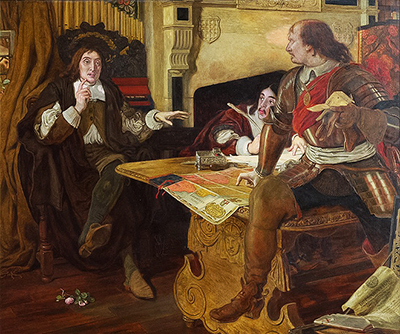Cromwell, the Protector of the Vaudois, involves a painting that was done in the year 1877 by Ford Madox Brown. The painting indicates Oliver Cromwell having an in-depth discussion with John Milton through a written letter.
The letter dictated to Andrew Marvell objecting to the 1655 mass killing that took place at the Piedmontese Easter slaughter, an assault on the Vaudois. This mistreated Protestant group was located in Piedmont, the northern part of the Italian territory. The painting was Ford Madox's second Oliver Cromwell piece of artwork painting after the first one done in 1875 "Cromwell on his Farm". The Cromwell, Protector of the Vaudois painting by Ford Madox Brown, was done using oil on canvas.
Following the successive rounds of exterminations and deprivation of land, property, or other possessions of Vaudois in Italy, Cromwell decided to organize a global action for their sake, composing letters, raising money related commitments for casualties, and threatening to initiate military interventions. Throughout his lifespan, the dictators restrained back their assaults; however, after his passing on, the Vaudois were over and over abused. Milton's work "On the Late Slaughter in Piedmont" ("Retaliate O Master for thy butchered holy people") was as well-composed as at the time about the slaughters.
After publishing Thomas Carlyle's 1845 Oliver Cromwell's letters and speeches, with clarifications, Cromwell was routinely depicted heroically in English craftsmanship. His activities concerning the Vaudois had been outlined a few times. Ford Madox Brown was commissioned by Charles Rowley to make the painting. Rowley said, "I authorized him to make a fine painting for me now at Manchester, "Cromwell, Defender of the Vaudois." I needed a painting of John Milton, and the outcome is this perfect work of art: Cromwell, Milton, and Andrew Marvell, who was then secretary to the visually impaired poet.
Ford Madox's painting contrasts from previous versions of the scenery due to its exceptionally unique arrangement intended to highlight the connection between Cromwell as a man of activity and Milton as an incredible scholarly power, with Marvell vigorously ready to execute their consolidated wills. As such, the painting is an improvement of the focal topic of Ford Madox's prior painting Work, however, in this particular scenario emphasizes the piece of artwork "power elite" as opposed to standard physical work. Cromwell's posture, spread over the desk, is an improvement of previous symbolism in which Cromwell had been portrayed as an unpleasant or unceremonious figure. His contained vitality is stressed by the dubiously adjusted desk, bolstered on a bent base with little balancing out feet. Milton's signal is comparatively momentary, finger raised, while the cropped, half-darkened figure of Marvell holds his pen readily waiting.




